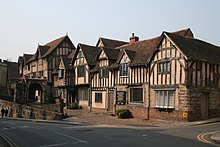 | ||
| Warwick | ||
| country | England | |
|---|---|---|
| Residents | 32.719 (2016) | |
| height | 73 m | |
| no tourist info on Wikidata: | ||
| location | ||
| ||
Warwick (Pronunciation ˈwɒrɪk, roughly Worrik) is a city in the West Midlandswhich is known for its castle and medieval buildings.

background
getting there
By plane
The nearest commercial airport is in Birmingham Airport![]() (IATA: BHX). Another alternative are the London airports and above all London Heathrow Airport
(IATA: BHX). Another alternative are the London airports and above all London Heathrow Airport![]() (IATA: LHR) and London Luton Airport
(IATA: LHR) and London Luton Airport![]() (IATA: LTN), due to its geographical location and convenient connection to the motorway network (if you continue your journey by car).
(IATA: LTN), due to its geographical location and convenient connection to the motorway network (if you continue your journey by car).
By train
Warwick Central Station, the Warwick railway station is located on Coventry Road, next door Priory Park. There are connections to the nearby Leamington Spa, as well as after Birmingham and London Marylebone With Chiltern Railways. The train station is just outside the city Warwick Parkway.
In the street
Warwick is on the M40 (Birmingham-London) and the A46 (e.g. to Stratford upon Avon) and can be reached very well on the road.
By boat
The Grand Union Canal and the river Avon flow through Warwick and hundreds of small motor boats come and go here every year.
mobility
Tourist Attractions
- Warwick Castle

- In addition to the castle, there are still some in the village medieval buildingthat survived a major city fire in 1649. These are located on the Mill Street. Another building is this Lord Leycester hospital, today a retirement home for former soldiers, that is right next to the medieval chapel Chapel of St James the Great is located. There are also remains of the former city wall. These are two gates that Eastgate and the Westgate.
- Collegiate Church of St Mary. The church was also destroyed during the great fire and reopened after its reconstruction in 1704. It is a typical Gothic church and is located in the city center just east of the market square.
activities

shop
kitchen
nightlife
accommodation
health
Practical advice
trips
- Birmingham
- Stratford upon Avon - William Shakespeare's birthplace
literature
Web links
- http://www.warwick-uk.co.uk/ - Warwick Official Website



_AN1572653.jpg/350px-London_-_Heathrow_(LHR_-_EGLL)_AN1572653.jpg)

